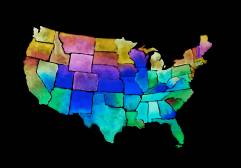Survey: budget outlook for states improving
Is the fiscal situation finally getting better for states? Kind of.
The National Governors Association and the National Association of State Budget Officers released a new report, “The Fiscal Survey of States,” that paints a slightly positive picture as after a half decade of slow recovery following the 2008 recession, states are seeing some fiscal relief.
However, the survey notes that with a still high unemployment rate, the economic recovery is weak compared to other post-recession recoveries.
“Revenue collections increased more than previously expected in fiscal 2013, but states are just coming off years of constrained budgets,” said NASBO Executive Director Scott Pattison. “We do expect state spending to improve in fiscal 2014, however, there is still plenty of demands on states.”
Since 1979, NASBO and NGA have published the “The Fiscal Survey of States.” The report presents aggregate and individual data on the states’ general fund receipts, expenditures and balances. Although not the totality of state spending, these funds are raised from state’s own taxes and fees, such as state income and sales taxes. These general funds are used to finance most broad-based state services and are the most important elements in determining the fiscal health of the states.
A separate survey that includes total state spending, NASBO’s “State Expenditure Report,” also is conducted annually.
The surveys were completed by governors’ state budget officers in all 50 states. The survey also includes Puerto Rico, however, its data is not included in the 50 state totals. Fiscal 2012 data represent actual figures, fiscal 2013 figures are estimated, and fiscal 2014 data reflect governors’ recommended budgets.
The most recent report says that states are challenged with providing resources in critical areas that were cut during the recession, declining federal funds for state programs subject to sequestration and continued spending demands such as Medicaid, higher education and corrections. Because of these, the report says, states are expected to “moderately” increase spending in the 2014 fiscal year.
That ties into increases in both state general funds expenditures and revenues. Expenditures are projected to increase 4.1 percent, a number below less than the historical average while revenues are expected to increase 2.8 percent, also below the historical growth rate.
“State spending in fiscal 2013 is still below the fiscal 2008 pre-recession peak,” said NGA Executive Director Dan Crippen in a released statement. “Lower real-spending levels in fiscal 2013 compared to fiscal 2008 indicate that state budgets are not growing fast enough to make up for recession-induced declines and inflation. Additionally, governors are aware that the federal spending cuts started by sequestration will only get worse.”
Key figures from the survey:
- Aggregate general fund spending in fiscal 2013 is estimated to increase 4 percent over the $672 billion in general fund spending in fiscal 2012.
- Fiscal 2014 recommended general fund expenditures total $728 billion, a 4.1 percent increase over an estimated $699 billion in fiscal 2013.
- Medicaid represents the single largest portion of total state spending, estimated to account for 23.9 percent of total spending in fiscal 2012.
- States continue to experience strong gains in personal income tax collections, which are estimated to have increased by 6.2 percent in fiscal 2013 and are projected to increase by 3.7 percent in fiscal 2014. That number could be slightly skewed though as taxpayers shifted capital gains, dividends and personal income to calendar year 2012 to avoid new federal tax laws.
- Collections from sales taxes have not rebounded as rapidly since the end of the recession, increasing by 0.9 percent in fiscal 2012. Sales tax collections are estimated to increase by 3.9 percent in fiscal 2014.
- While continuing to outpace retail sales as a whole, many online retail sales are not contributing to state sales tax revenues because in many instances the sales tax goes uncollected. Annually, states fail to collect more than $23 billion from transactions conducted over the Internet or through catalogues.





